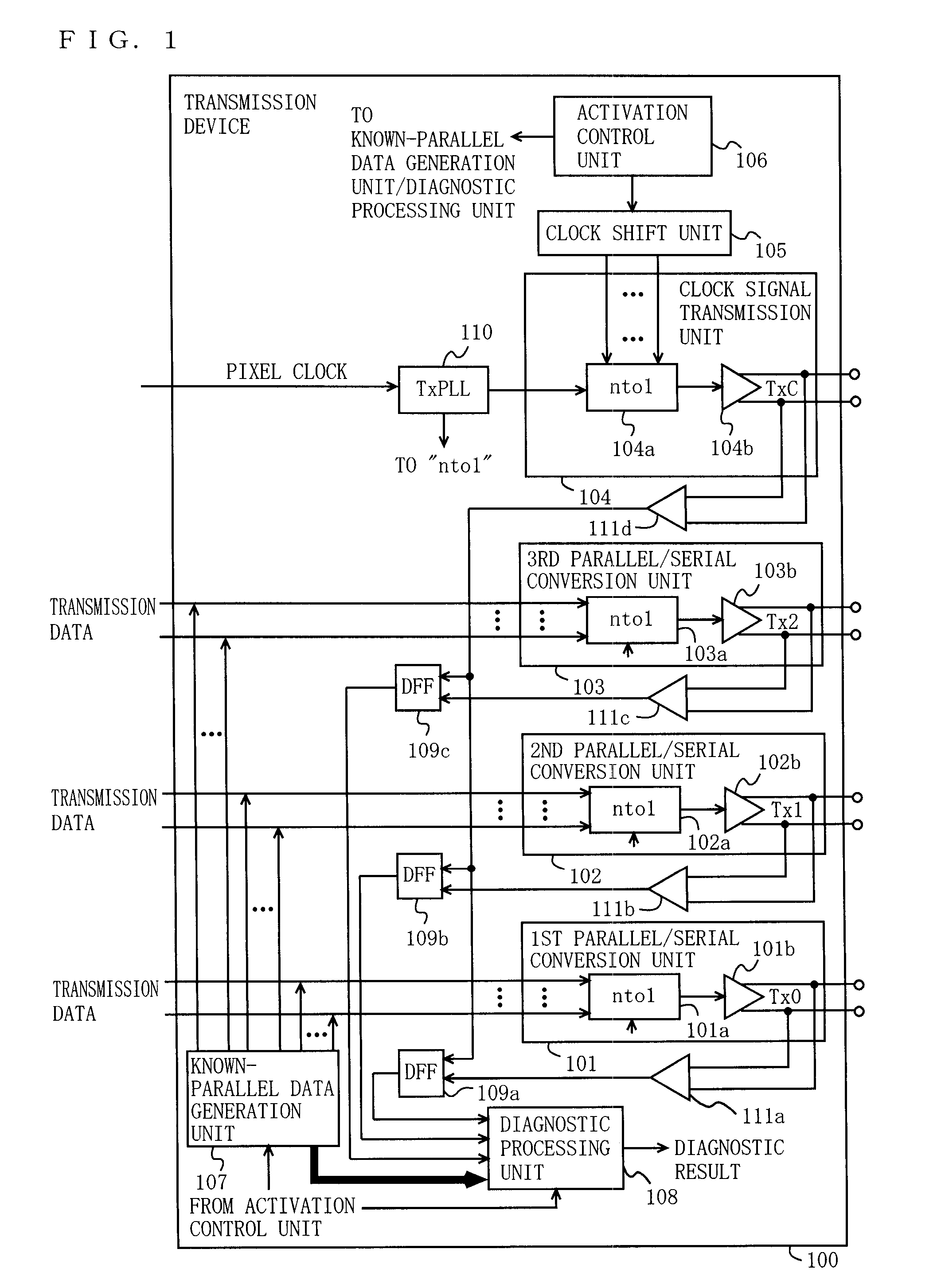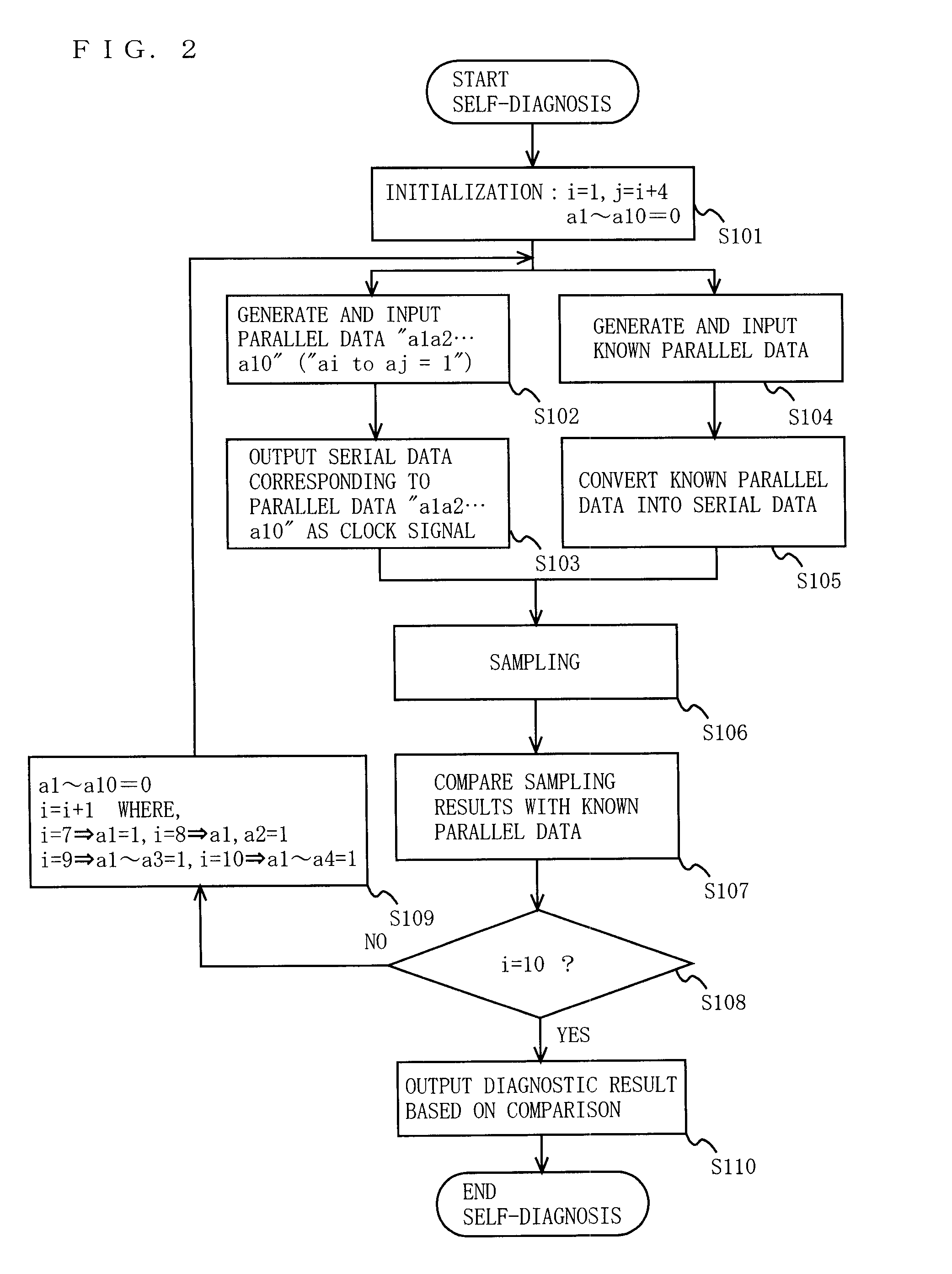Transmission device and electronic apparatus with self-diagnostic function, and self-diagnostic method for use therein
a technology of transmission device and electronic apparatus, which is applied in the direction of digital transmission, pulse technique, local circuit, etc., can solve the problems of extremely high transfer speed and extremely high test cos
- Summary
- Abstract
- Description
- Claims
- Application Information
AI Technical Summary
Benefits of technology
Problems solved by technology
Method used
Image
Examples
first embodiment
[0057]FIG. 1 is a block diagram illustrating the functional configuration of a transmission device 100 according to a first embodiment of the present invention. In FIG. 1, the transmission device 100 includes first through third parallel / serial conversion units 101, 102, and 103, a clock signal transmission unit 104, a clock shift unit 105, an activation control unit 106, a known-parallel data generation unit 107, a diagnostic processing unit 108, delay flip-flops (DFFs) 109a, 109b, and 109c, a transmission phase-locked loop circuit (TxPLL) 110, and receivers 111a, 111b, 111c, and 111d. The first parallel / serial conversion unit 101 includes a parallel / serial converter (labeled “nto1” in the figure (like elements are labeled similarly)) 101a, and a differential output circuit 101b. The second parallel / serial conversion unit 102 includes a parallel / serial converter 102a, and a differential output circuit 102b. The third parallel / serial conversion unit 103 includes a parallel / serial co...
second embodiment
[0089]FIG. 4 is a block diagram illustrating the functional configuration of a transmission device 200 according to a second embodiment of the present invention. In FIG. 4, elements having similar functions to those in the first embodiment are denoted by the same reference numerals, and the descriptions thereof will be omitted. The second embodiment differs from the first embodiment in terms of the configuration for shifting the clock signal by 1 UI.
[0090]In FIG. 4, the clock signal transmission unit 204 includes a PLL circuit 244, and a differential output circuit 104b. The PLL circuit 244 includes a TxPLL 214, a frequency dividing circuit 224, and a delay circuit 234. The TxPLL 214 increases the frequency of the pixel clock n-fold. The frequency dividing circuit 224 reduces the frequency of the output from the TxPLL 214 to 1 / n. The delay circuit 234 delays the output of the frequency dividing circuit 224 under the control of the clock shift unit 205. When instructed by the activat...
third embodiment
[0098]In a third embodiment of the present invention, the transmission device is configured similarly to those in the first and second embodiments, and therefore FIG. 1 or 4 will be referenced. In the first and second embodiments, the clock signal TxC is shifted by 1 UI, but in the third embodiment, the clock signal TxC is continuously or gradually shifted by 1 UI within a predetermined period (e.g., a period in which jitter tends to occur, such as a period in which the data signal rises or falls).
[0099]FIG. 7 is a schematic diagram for explaining the operation of the transmission device according to the third embodiment. The transmission data (here, Tx0 is taken as an example) has jitter at its rising edge (or falling edge). In the absence of jitter (indicated by bold doted lines in the figure), the transmission device can ideally make a self-diagnosis. However, in the presence of jitter (indicated by thin lines on the figure), even if the sampling results are consistent with the k...
PUM
 Login to View More
Login to View More Abstract
Description
Claims
Application Information
 Login to View More
Login to View More - R&D
- Intellectual Property
- Life Sciences
- Materials
- Tech Scout
- Unparalleled Data Quality
- Higher Quality Content
- 60% Fewer Hallucinations
Browse by: Latest US Patents, China's latest patents, Technical Efficacy Thesaurus, Application Domain, Technology Topic, Popular Technical Reports.
© 2025 PatSnap. All rights reserved.Legal|Privacy policy|Modern Slavery Act Transparency Statement|Sitemap|About US| Contact US: help@patsnap.com



